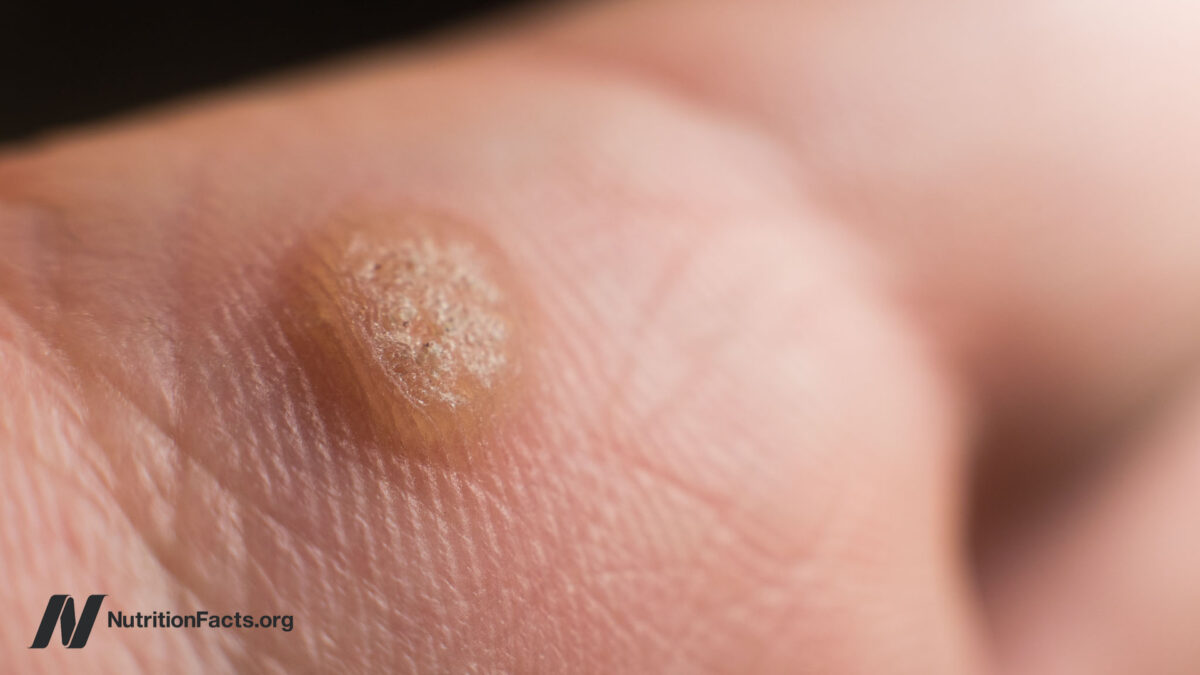Duct tape beat out ten other wart treatments for cost and effectiveness, so why isn’t it standard practice?
One of the “unusual, innovative, and long-forgotten remedies” noted in a dermatology journal article was the use of duct tape to cure warts. It was finally put to the test. There are all sorts of conventional therapies, from acid to cryosurgery to lasers, but most are “expensive, painful, or labor intensive,” whereas the simple application of duct tape is none of those and may even be more effective than trying to freeze off the warts.
As I discuss in my video Can You Really Remove Warts with Duct Tape?, some doctors lauded the study, noting they had been using duct tape as a “painless, yet effective, therapy for several decades,” instead of “surgery and other destructive therapies.” Said one physician, “Sometimes, when I’ve mentioned this type of therapeutic option to a patient, they will look at me as if I’ve lost my mind! When the treatment works, however, they appreciate the wisdom of my advice and my ‘minimal discomfort and fuss’ philosophy.”
Other doctors were not so amused. After spending money on all sorts of fancy equipment, along comes duct tape? Studies like that “could damage the reputation of cryosurgery,” wrote one physician, who also complained that the ten-second application of liquid nitrogen used in the study was too short, so it was an unfair comparison. And, evidently, you really have to get in there and freeze until there is a blistering reaction. It’s painful, but too bad. The doctor even joked and made light of a poor child who, before each freezing treatment session, vomited out of fear of the pain!
Did he have a point, though, about the ten seconds? In the trial comparing duct tape to cryotherapy, those ten-second cryotherapy treatments worked 60 percent of the time, which is actually better than the results of most cryotherapy studies that only seemed to cure about 50 percent. In fact, typical cryotherapy for warts works so poorly that, statistically, it didn’t even beat out placebo, so all of that pain may have been for nothing, though aggressive cryotherapy does seem to work better.
What they should have done, wrote another doctor in response to the duct tape trial, is take a scalpel to the wart and really blister it before going back a week later and trying to cut and crater it out. Maybe even go back a third time. ”If the procedure I detailed had been followed, the resolution rate would have been closer to 90%”—but at what cost? In the duct tape trial, one patient “lost his study wart in a trampoline toe-amputation accident.” (Amputation—a 100 percent effective treatment!) But, at what cost? In this study, 85 percent of the duct tape patients were cured without any pain or tissue damage, whereas aggressive cryotherapy may require lidocaine injection nerve blocks, “taking the cry out of cryotherapy.” It can also cause permanent tissue damage. As you can see below and at 2:48 in my video, you can end up with big, necrotic, frostbite lesions. In one sense, tissue damage is the whole point of freezing warts, but you can end up causing deep burns, rupturing tendons, which can cause permanent disability, or causing extensive scarring in rare cases. Just the psychological stress of having to keep going back for such a painful procedure may ironically impair our ability to fight off the wart viruses in the first place.
 So, “even if the effectiveness of duct tape occlusion is shown to be merely equivalent to that of cryotherapy,” duct tape would be better. And it was shown to be even more effective than cryotherapy; in fact, duct tape may be the most effective treatment. As you can see in the graph below and at 3:25 in my video, compared to ten other wart treatments, duct tape beat them all in terms of effectiveness and cost. It was cheaper than all but the “DN” option, with DN standing for Do Nothing. Compared to the most cost-effective prescription treatments available, over-the-counter duct tape is ten times cheaper. “It is an unusual and welcome event in health care when a common ailment is proven equally amenable to an inexpensive, tolerable, and safe alternative therapy.”
So, “even if the effectiveness of duct tape occlusion is shown to be merely equivalent to that of cryotherapy,” duct tape would be better. And it was shown to be even more effective than cryotherapy; in fact, duct tape may be the most effective treatment. As you can see in the graph below and at 3:25 in my video, compared to ten other wart treatments, duct tape beat them all in terms of effectiveness and cost. It was cheaper than all but the “DN” option, with DN standing for Do Nothing. Compared to the most cost-effective prescription treatments available, over-the-counter duct tape is ten times cheaper. “It is an unusual and welcome event in health care when a common ailment is proven equally amenable to an inexpensive, tolerable, and safe alternative therapy.”

Hold on. If you look at the latest Cochrane review, which many consider to be the gold standard of evidence-based reviews, it acknowledges that cryotherapy “is less convenient, more painful, and also more expensive,” but despite being excited about the effectiveness of duct tape in an earlier review, in two subsequent studies, duct tape seemed to totally flop. So, should we give up on duct tape for warts, or is there another side of the story? You can find out the thrilling conclusion in Which Type of Duct Tape Is Best for Wart Removal?, the next and final video in this three-part series.
This is the second video in my three-part series. If you missed the first video, check out Duct Tape and Wart Removal.
